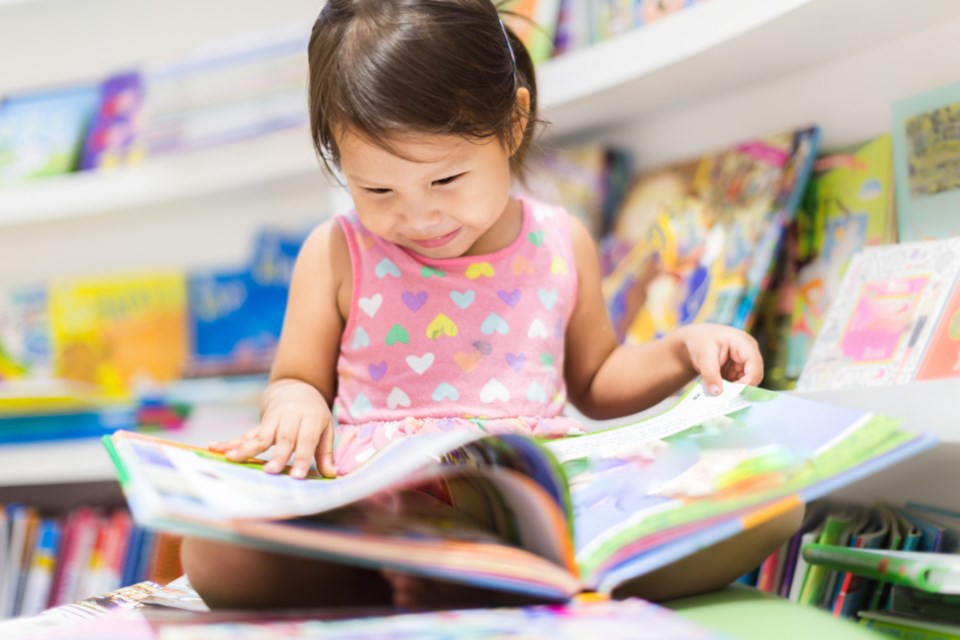This article, written by Lotje Hives, Nipissing University and Tara-Lynn Scheffel, Nipissing University, originally appeared on The Conversation and has been republished here with permission:
A preschooler’s day is a world of adventure fuelled by an unbridled imagination. Sparked by curiosity, they set out to discover anything and everything new while sharing about their discoveries. Young children’s learning develops through making and testing theories continually. It’s exhilarating work!
When adults notice children’s ideas and theories as well as name and build children’s vocabulary through talk, or when they encourage children to make connections to previous experiences as they read together, they help nourish positive attitudes about literacy.
For those slow-down moments when you as a child’s caregiver are looking for ways to model and enjoy literacy together, one cost-friendly idea is to create a nook or nest (indoors or out) for reading. Your book nest can be as uncomplicated as gathering a sheet, some clothespins, the couch cushions and a couple of chairs.
Loose parts play
What is the source of all the excitement? When the child, with you alongside, can use these items to design a little tent or cushion nest, they are engineering spaces of their very own. The child is experiencing what early childhood development experts call loose parts play: through manipulating free and loose parts, children delight in becoming architects of spaces they share.
With loose parts play, items can be used in multiple ways for designing, creating and testing prototypes. Every peg point and toppled pillow will offer problem-solving scenarios that call for solutions. And let’s not forget that with some pillows and soft blankets inside, the opportunity arises for the caregiver to lay back and relax!
Next, consider having your child fill an old cereal box, basket or cloth tote full of their favourite books to explore in their newly designed space.
Books for your cozy space
These seven titles are packed full of adventure and are worth a look at your local library. You may find your child asks to read favourite books over and over, celebrating the joy of reading!
1. Knuffle Bunny
Picture books with human characters offer opportunities to explore pro-social behaviour. In Knuffle Bunny, a family’s trip to the laundromat leads to mapping their way through the neighbourhood and exploring how faces and body language express how people feel. In the streetscape depicted, your child may recognize what early childhood educators talk about as environmental print — signs, labels and logos visible in our everyday world. Children’s early curiosity about text and signs all around them is part of a first stage of reading awareness. They will begin to read the environmental print as they recognize shapes, colours, numbers and letters.
2. Not a Box
Children see beauty in the items that adults might otherwise discard. In a time when it is necessary to encourage environmental sustainability and ecological understandings, what’s stopping us from slowing down and offering some otherwise recyclable materials like boxes and other found materials to become robots, wands, puppets, tents and playhouses? Not a Box invites predicting what’s next and chiming in with each page as your child imagines “It’s not a box, it’s a …”
3. Lost in the Woods
Children can imagine themselves in other places and spaces sparked by rich illustrations in picture books. Lost in the Woods takes you on an imaginary journey into the outdoors and is a perfect story to spark connections and questions about the natural world. You might even imagine you are camping in your reading tent!
4. My Heart Fills With Happiness
This book, by an author of Cree, Lakota and Scottish ancestry, is also available in a bilingual Plains Cree edition, Ni Sâkaskineh Mîyawâten Niteh Ohcih translated by Mary Cardinal Collins. It offers a wonderful opportunity to talk about emotions as it explores the concept of what makes people happy and how people express joy in different ways. The author narrates moments such as the smell of warm bannock, providing opportunities to discuss distinct aspects of Indigenous cultures or histories, as well as the similarities children and families share.
5. Changes, Changes
A timeless, wordless book, Changes, Changes invites children to explore how building blocks and little figures can be used to tell endless stories. Each page invites discussion and creates opportunities for problem solving, language development, creativity, mathematics and more. Add some blocks to your reading nook to retell a story, recreate the illustrations or build new designs!
6. Five Little Monkeys Jumping on the Bed
Books that invite children to sing, dance and do actions with favourite childhood songs or chants are always popular. With Five Little Monkeys Jumping on the Bed, perhaps the reading tent sets the stage for an impromptu performance entertaining a friendly, appreciative audience.
7. If You Hold a Seed
The journey of a seed through the seasons comes to life in this cyclical story that begins with a young child wishing upon a seed. The text and illustrations in If You Hold a Seed will spark thoughtful discussions about hopes, dreams, wonders and wishes.
A reading nest, some favourite books and a sprinkle of giggles: a recipe sure to cook up a healthy love of reading, with moments of pure joy on the side.![]()
Lotje Hives, Research Collaborator, Part-time Instructor, Schulich School of Education, Nipissing University and Tara-Lynn Scheffel, Associate Professor, Schulich School of Education, Nipissing University
This article is republished from The Conversation under a Creative Commons license. Read the original article.
